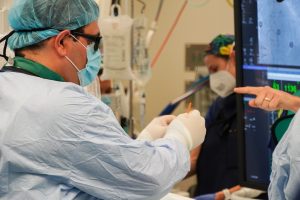Freedom from atrial fibrillation (AF) may be closer than first thought for many patients thanks to a new study showing the benefits of exercise.
The combined exercise and physical activity intervention run by the Centre for Heart Rhythm Disorders, a collaboration between the Royal Adelaide Hospital and University of Adelaide, significantly reduced symptoms and episodes of AF without the need for weight loss.
Problem without a cure
Atrial fibrillation is the most common heart rhythm disorder as well as the most common cardiac reason for presentation to hospital.
Even the best procedures, such as catheter ablation, are not curative, and modifying risk factors such as obesity, hypertension, and alcohol intake is a major focus for clinicians.
Until now, the evidence for exercise as a tool to manage non-permanent AF has been unclear.
The six-month exercise and physical activity intervention reduced recurrence of AF and severe symptoms.
Six months after the study, 24 (40 per cent) of participants in the exercise group were free of AF compared to 12 (20 per cent) in the non-exercise group.
“So that’s an additional 12 patients who may not need to be exposed to the risk of an ablation procedure,” said Dr Adrian Elliott.
“We think that’s a pretty significant thing – for the patient, but also the healthcare system in terms of healthcare costs and procedure waiting times.”
Exercising patients also experienced a significant reduction in self-reported symptom severity at six and 12 months.
“Symptoms are really first thing you’re trying to manage. We certainly wanted to examine AF recurrence, but importantly, we wanted to if patients feel better too.
“We hope this that study will influence upcoming international clinical guidelines for the management of AF, in particular by increasing the strength of recommendation for prescription of exercise in AF patients.”
Fitness first
While weight loss can be beneficial for patients with AF, the results of this study show that improvements in fitness have a big impact on quality of life, even without changes in body mass.
“Historically, this condition is treated with drug therapy and complex procedures, but we can see that we can make a difference by addressing modifiable risk factors such as exercise,” said Dr Adrian Elliott.
“It’s not all or nothing. You can start small, and gradually work your way to more intense exercise and see meaningful benefits for AF control.”
What’s next?
Dr Elliott and his colleagues have further work in the pipeline, such as examining whether the results of this study persist beyond 12 months and how they impact hospitalisations, and better understanding how exercise improves AF.



